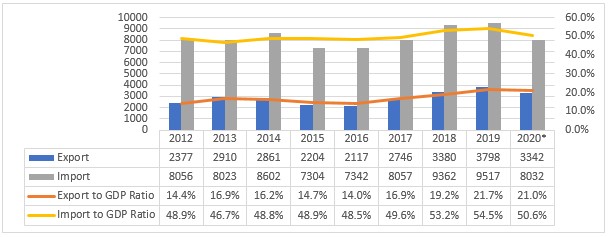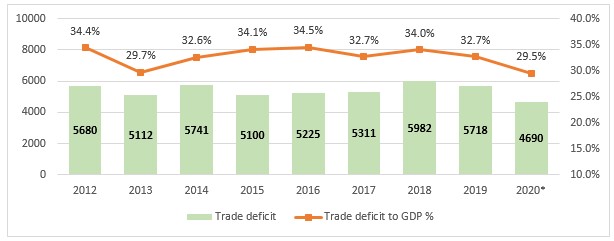Irakli Gharibashvili: “The value of goods exported in 2012 was USD 2.4 billion and this figure was USD 3.3 billion in 2020.”
Verdict: FactCheck concludes that Irakli Gharibashvili’s statement is MOSTLY TRUE.
Resume:
The National Statistics Office of Georgia publishes data about foreign trade. In 2020, the value of goods exported amounted to USD 3.3 billion which is nearly USD 1 billion more as compared to 2012’s figure. The figures in the Prime Minister’s statement are true. However, analysing economic indicators to the GDP ratio is a relevant approach in terms of a time dynamic. In 2012, the export to the GDP ratio was 14.4% whilst export constituted 21% of the GDP in 2019-2020.
The trade deficit, which is a certain indicator of foreign trade success, has to be analysed whilst speaking about foreign trade. In 2020, the foreign trade deficit was almost USD 1 billion less as compared to 2020’s figure. However, this was largely stipulated by shrinking imports as a result of pandemic-related restrictions. In 2019, the trade deficit was USD 40 million more as compared to 2012’s figure, although the trade deficit to the GDP ratio was lower in 2019 which is a positive fact. It was only in 2016 when the trade deficit was deeper as compared to 2012 whilst the trade deficit dynamic was fluctuating between 2012 and 2019. Therefore, it is difficult to speak about a clear positive trend in foreign trade in general as opposed to the export dynamic taken separately.
Analysis
The Prime Minister of Georgia, Irakli Gharibashvili, in his speech before the Parliament of Georgia, stated: “The value of goods exported in 2012 was USD 2.4 billion and this figure was USD 3.3 billion in 2020.” It is our task to make exports of USD 5 billion in the upcoming years.”
The National Statistics Office of Georgia publishes data about foreign trade. In 2020, the value of goods exported amounted to USD 3.3 billion which is nearly USD 1 billion more as compared to 2012’s figure. The figures in the Prime Minister’s statement are true. However, analysing economic indicators to the GDP ratio, particularly foreign trade statistics to the GDP ratio, is a relevant approach. In 2012, the export to the GDP ratio was 14.4% whilst export reached 21% of the GDP in 2019-2020 which means that the share of exports in the GDP was growing. Therefore, the Prime Minister’s emphasis on a positive dynamic does correspond to reality. The export of locally produced goods to the GDP and to the total export ratio increased and, naturally, this is a positive occurrence.
Graph 1: Foreign Trade Dynamic in 2012-2020, USD Million

Source: National Statistics Office of Georgia
The trade balance, which is a certain indicator of import-dependence, has to be analysed whilst speaking about foreign trade. Along with the growth of export, import has also been growing in the past years which stipulated the widening foreign trade misbalance in some years and caused a decline in the gross domestic product and the currency outflow. In 2020, the foreign trade deficit was almost USD 1 billion as compared to 2020’s figure, although this was largely caused by shrinking imports as a result of pandemic-related restrictions. In 2019, the trade deficit was USD 40 million more as compared to 2012’s figure, although the trade deficit to the GDP ratio was lower in 2019 which is a positive fact. It was only in 2016 when the trade deficit was deeper as compared to 2012 and the trade deficit dynamic was fluctuating between 2012 and 2019. Therefore, it is difficult to speak about a clear-cut positive trend.
Graph 2: Trade Deficit in 2012-2020, USD Million

Source: National Statistics Office of Georgia








